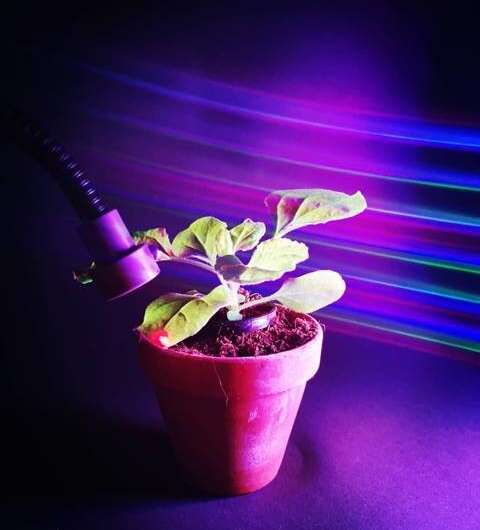Scientists have found a way to control different plant processes -- such as when they grow -- using nothing but colored light.The development reveals how coloured light can be used to control biological processes in plants by switching different genes on and off. PULSE enables targeted and reversible gene expression control in plants in the presence of ambient light. The researchers hope that their findings could lead to advances in how plants grow, flower, and adapt to their environment, ultimately allowing increases in crop yields. Credit: Leonie-Alexa Koch, Institute of Synthetic Biology, University of Düsseldorf.
University of East Anglia scientists have helped find a way to control different plant processes—such as when they grow—using nothing but colored light.
The development, published today in the journal Nature Methods, reveals how colored light can be used to control biological processes in plants by switching different genes on and off.
The researchers hope that their findings could lead to advances in how plants grow, flower, and adapt to their environment, ultimately allowing increases in crop yields.
The research was led by Heinrich Heine University and the Cluster of Excellence on Plant Sciences (CEPLAS) in Düsseldorf, in collaboration with colleagues at the University of Freiburg and UEA.
Dr. Ben Miller, from UEA's School of Biological Sciences, said: "Our team have been working on optogenetics—using light to precisely control biological processes—in plants.
"Using optogenetics in plants hadn't been possible before because plants naturally respond to light as they grow. Any genetic switches controlled by light would therefore be constantly active.
"But we have developed a special system which overcomes this problem and allows us to control different cellular processes in plants using light.
"We can now use a red light to cause gene expression at a precise moment, while an ambient white light can be used as an 'off switch' to reverse the process. This can be repeated any number of times.
"We can use this system to manipulate physiological responses in plants, for example their immune response, and perhaps their development, growth, hormone signaling and stress responses."
The project bridges two hot topics in biology—optogenetics and synthetic biology.
The new tool called PULSE (Plant Usable Light-Switch Elements) is suitable for plants growing under normal day and night cycles.
Dr. Miller said: "In the future, this research might mean that we can modulate how plants grow, and respond and adapt to their environment, with light cues.
"For example, we have shown that plant immune responses can be switched on and off using our light-controlled system. If this system was used in crops, we could potentially improve plant defenses to pathogens and have an impact by improving yields.
"Using light to control biological processes is far less invasive and more reversible than using chemicals or drugs, so this new system in plants is a really exciting new tool for us to answer fundamental questions in plant biology."
More information: Optogenetic control of gene expression in plants in the presence of ambient white light , Nature Methods (2020). DOI: 10.1038/s41592-020-0868-y , www.nature.com/articles/s41592-020-0868-y
Journal information: Nature Methods
Provided by University of East Anglia
























